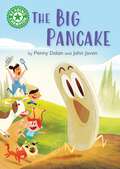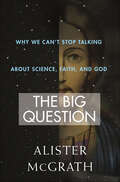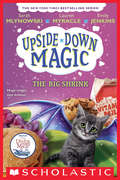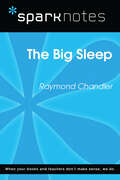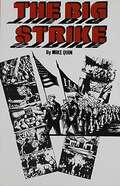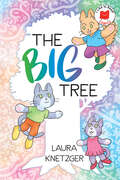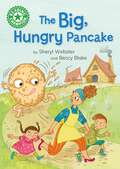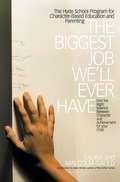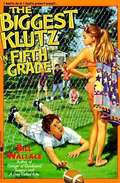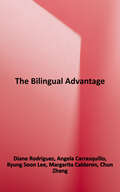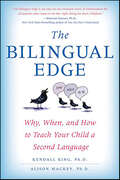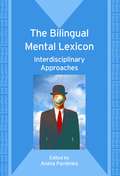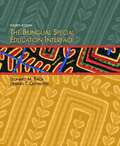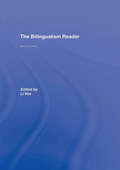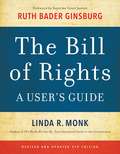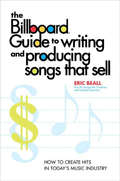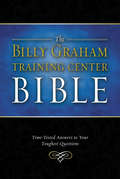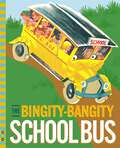- Table View
- List View
The Big Pancake: Independent Reading Green 5 (Reading Champion #528)
by Penny DolanThis story is part of Reading Champion, a series carefully linked to book bands to encourage independent reading skills, developed with Dr Sue Bodman and Glen Franklin of UCL Institute of Education (IOE)In this retelling of a traditional tale, a woman makes the biggest pancake ever but the pancake runs away! Everyone chases it, but they cannot catch the pancake. Then the pancake comes to a river ...Reading Champion offers independent reading books for children to practise and reinforce their developing reading skills.Fantastic stories are accompanied by engaging artwork and a reading activity. Each book has been carefully graded so that it can be matched to a child's reading ability, encouraging reading for pleasure. This retelling of the original traditional tale is suitable for children aged 5-7, or those reading at book band Green 5.
The Big Question: Why We Can’t Stop Talking About Science, Faith and God
by Alister McGrathRichard Dawkins's groundbreaking book The God Delusion created an explosion of interest in the relation of science and faith. This often troubled relationship between science and religion was seemingly damaged by the rise of the New Atheism, which insisted that science had essentially disproved not just God but also the value of religion. There is increasing skepticism towards its often glib and superficial answers; and the big questions about faith, God and science haven't gone away--in fact, we seem to talk about them more than ever. Alister McGrath's The Big Question is an accessible, engaging account of how science relates to faith, exploring how the working methods and assumptions of the natural sciences can be theologically useful. McGrath uses stories and analogies, as well as personal accounts, in order to help readers understand the scientific and theological points he makes, and grasp their deeper significance. An extremely accomplished scientist and scholar, McGrath criticizes the evangelism of the New Atheists and paves a logical well-argued road to the compatibility between science and faith.Some of his main discussion points include:1. There is much more convergence between science and faith than is usually appreciated2. How the three great models of scientific explanation can be adapted to religious belief3. Belief in God provides a 'big picture' of reality, making sense of science's successes
The Big Shrink (Upside-Down Magic #6)
by Lauren Myracle Sarah Mlynowski Emily JenkinsThe Upside-Down Magic kids are back in another topsy-turvy adventure in the next installment of this New York Times bestselling series, now a Disney Channel Original Movie!Marigold Ramos can magically make things small - sometimes very, very small. The only problem? She can't figure out how to make them big again. Maybe a new tutor can help Marigold manage her magic. And maybe her magic will come in handy as she and her friends in the Upside-Down Magic class band together to protest a new rule by their principal, a super unfair rule that bans them from bringing their amazing new toy dragons to school.But when Marigold starts shrinking her friends and the class bunny, it's a humongous problem! It's time to figure out how Marigold and her friends can make a big statement... without disappearing entirely!
The Big Sleep (SparkNotes Literature Guide Series)
by SparkNotesThe Big Sleep (SparkNotes Literature Guide) by Raymond Chandler Making the reading experience fun! Created by Harvard students for students everywhere, SparkNotes is a new breed of study guide: smarter, better, faster.Geared to what today's students need to know, SparkNotes provides:chapter-by-chapter analysis explanations of key themes, motifs, and symbols a review quiz and essay topics Lively and accessible, these guides are perfect for late-night studying and writing papers.
The Big Story: How the Bible Makes Sense out of Life
by Justin BuzzardHow would you explain your life to a stranger?When strangers meet today, they often ask not, "What do you do?" but, "What is your story?" Everybody on the planet believes some larger story in order to make sense of the smaller story of his or her life. We want our lives to fit within a larger plot—a plot full of history, forward movement, and future.So, the better question to ask is, "What sort of story are you in?"Most people believe false stories that leave them disillusioned, enslaved, and hopeless. Secular stories of chasing success and religious stories of doing good works leave us feeling exhausted and empty. Only Christianity offers a story that's big enough to make sense of both the beauty and brokenness in our lives and in our world.
The Big Story: How the Bible Makes Sense out of Life
by Justin BuzzardHow would you explain your life to a stranger?When strangers meet today, they often ask not, "What do you do?" but, "What is your story?" Everybody on the planet believes some larger story in order to make sense of the smaller story of his or her life. We want our lives to fit within a larger plot—a plot full of history, forward movement, and future.So, the better question to ask is, "What sort of story are you in?"Most people believe false stories that leave them disillusioned, enslaved, and hopeless. Secular stories of chasing success and religious stories of doing good works leave us feeling exhausted and empty. Only Christianity offers a story that's big enough to make sense of both the beauty and brokenness in our lives and in our world.
The Big Strike
by Mike QuinThe story of the great 1934 general strike in San Francisco. A classic of working-class journalism.
The Big Tree (I Like to Read Comics)
by Laura KnetzgerHow do you cheer up a friend?Kittens Max, Cantaloupe, and Melon love the Big Tree. In spring, they climb it. In summer, they stargaze on it. In autumn, they play in its leaves. It&’s always been there. But now the Big Tree is sick. Really sick. And Melon and Cantaloupe&’s parents have to cut it down. Max is sad to lose the Big Tree, but he&’s even sadder for his friends. The Big Tree was in their yard for their whole lives—it was their friend. More than anything, Max wants to cheer them up. He thinks about it and thinks about it, and finally it comes to him: with some allowance money, some elbow grease, and a lot of beautiful potted plants, he can help them grow new and beautiful flowers in their sunny backyard! A sensitive and age-appropriate story about loss, friendship, and the power of kindness, THE BIG TREE is a perfect text for teaching beginning readers emotional intelligence, change acceptance, and the value of positive action. A touching and brightly drawn beginner comic from Ignatz Nominee Laura Knetzger, THE BIG TREE is heartfelt, tender, and warm. Comics-lovers can now share the fun with their kids, students, siblings, and younger friends who are learning to read! I Like to Read® Comics are perfect for kids who are challenged by or unengaged in reading, kids who love art, and the growing number of young comics fans. Filled with eye-catching art, humor, and terrific stories these comics provide unique reading experiences for growing minds. I Like to Read® Comics, like their award-winning I Like to Read® counterpart, are created by celebrated artists and support reading comprehension to transform children into lifelong readers. We hope that all new readers will say, &“I like to read comics!&”
The Big, Hungry Pancake: Independent reading Green 5 (Reading Champion #517)
by Sheryl WebsterThis story is part of Reading Champion, a series carefully linked to book bands to encourage independent reading skills, developed with Dr Sue Bodman and Glen Franklin of UCL Institute of Education (IOE) Fantastic, original stories are accompanied by engaging artwork and a reading activity. Each book has been carefully graded so that it can be matched to a child's reading ability, encouraging reading for pleasure. Perfect for 5-7 year olds.In this twist on the traditional tale The Big Pancake, a woman makes a pancake for the hungry children, but the pancake is hungry too, and it wants to eat them!
The Biggest Bully in Brookdale
by Carol GormanAccording to Roger, Brad Garth, the bully, 'eats little kids for breakfast.' Brad beats up on kids and makes life miserable. Find out how the Tree House Kids solve the bully problem.
The Biggest Job We'll Ever Have
by Marc Brown Laura Gauld Malcolm GauldATTITUDE OVER APTITUDE. EFFORT OVER ACHIEVEMENT. CHARACTER OVER TALENT. For families, educators, corporations, and communities, The Biggest Job We'll Ever Have is nothing less than a new paradigm for reconnecting education with core values. With more than thirty-five years' experience at Hyde, an organization of internationally known, award-winning schools and programs, Laura and Malcolm Gauld argue persuasively that true education for our children springs not just from seeking good grades and achievements but from reestablishing a true commitment to character, attitude, and a sense of purpose. The Hyde program emphasizes ten core beliefs -- the school's 10 Priorities -- that address how families can find the right balance between character and achievement. The results have been nothing short of astonishing: Children of all abilities and from every background have succeeded far beyond any expectations of them, both personally and academically, thanks to what they and their families have learned at Hyde. Unlike other education books that focus on the child, The Biggest Job We'll Ever Have focuses on a child's primary teacher -- the parent. The Gaulds explain that parents have an enormous impact on how their children approach education and life. They describe how parents can enhance their children's education by improving family dynamics and introducing honesty into all aspects of family life. And they detail the 10 Priorities clearly and logically, so that any family can embrace them. But that's only part of this book's appeal. Perhaps its true power comes from the dozens of Hyde parents and students who willingly share their own remarkable stories -- honest, funny, sad, moving, provocative -- that attest to the transformational power of the Hyde philosophy. Being a parent and a child today isn't easy; so much that we thought was important simply is not. As parents and educators, Laura and Malcolm Gauld believe that the way to motivate kids and build stronger families is to focus on identifying what is truly important. In The Biggest Job We'll Ever Have, they do exactly that.
The Biggest Klutz in Fifth Grade
by Bill WallaceNeal Moffet had called me "Fat Pat Berry, the Twinkletoes Fairy" one time too many. And when he started going on about what a klutz I was just because a flying tackle got me stuck under a chain-link fence...well, something snapped.So when he bet me I couldn't get through the summer without getting stitches or breaking any bones, I took him on. Whoever lost had to kiss Kristine Pimpton (otherwise known as "The Blimp") in front of the entire school on the first day of sixth grade.Just the thought of having to pucker up for those pudgy lips is enough to make me want to spend the summer sitting still. But the rules say I have to keep on playing football and basketball and riding bikes -- all that dangerous stuff. And Neal is so desperate to win, I don't trust him for a minute. Boy, is it going to be a long summer. Especially for a klutz like me.
The Bilingual Advantage: Promoting Academic Development, Biliteracy, and Native Language in the Classroom
by Angela Carrasquillo Diane Rodriguez Kyung Soon LeeThis comprehensive account of bilingualism examines the importance of using students’ native languages as a tool for supporting higher levels of learning. The authors highlight the social, linguistic, neuro-cognitive, and academic advantages of bilingualism, as well as the challenges faced by English language learners and their teachers in schools across the United States. They describe effective strategies for using native languages, even when the teacher lacks proficiency in a language. This resource addresses both the latest research and theory on native language instruction, along with its practical application (the what, why, and how) in K–8 classrooms. <p><p> Key features include: <p><p> Examples of programs that address the needs of learners from diverse language backgrounds, including Spanish, Chinese, Korean, Haitian Creole, Hindi, Bengali, and Russian. <p><p>Teaching strategies, activities, and student tasks geared toward current academic standards. <p><p>The role of primary language in ESL, dual language, special education, and general education programs.
The Bilingual Child
by Virginia Yip Stephen MatthewsHow does a child become bilingual? The answer to this intriguing question remains largely a mystery, not least because it has been far less extensively researched than the process of mastering a first language. Drawing on new studies of children exposed to two languages from birth (English and Cantonese), this book demonstrates how childhood bilingualism develops naturally in response to the two languages in the children's environment. While each bilingual child's profile is unique, the children studied are shown to develop quite differently from monolingual children. The authors demonstrate significant interactions between the children's developing grammars, as well as the important role played by language dominance in their bilingual development. Based on original research and using findings from the largest available multimedia bilingual corpus, the book will be welcomed by students and scholars working in child language acquisition, bilingualism and language contact.
The Bilingual Child
by Virginia Yip Stephen MatthewsHow does a child become bilingual? The answer to this intriguing question remains largely a mystery, not least because it has been far less extensively researched than the process of mastering a first language. Drawing on new studies of children exposed to two languages from birth (English and Cantonese), this book demonstrates how childhood bilingualism develops naturally in response to the two languages in the children's environment. While each bilingual child's profile is unique, the children studied are shown to develop quite differently from monolingual children. The authors demonstrate significant interactions between the children's developing grammars, as well as the important role played by language dominance in their bilingual development. Based on original research and using findings from the largest available multimedia bilingual corpus, the book will be welcomed by students and scholars working in child language acquisition, bilingualism and language contact.
The Bilingual Child
by Virginia Yip Stephen MatthewsHow does a child become bilingual? The answer to this intriguing question remains largely a mystery, not least because it has been far less extensively researched than the process of mastering a first language. Drawing on new studies of children exposed to two languages from birth (English and Cantonese), this book demonstrates how childhood bilingualism develops naturally in response to the two languages in the children's environment. While each bilingual child's profile is unique, the children studied are shown to develop quite differently from monolingual children. The authors demonstrate significant interactions between the children's developing grammars, as well as the important role played by language dominance in their bilingual development. Based on original research and using findings from the largest available multimedia bilingual corpus, the book will be welcomed by students and scholars working in child language acquisition, bilingualism and language contact.
The Bilingual Edge: Why, When, and How to Teach Your Child a Second Language
by Alison Mackey Kendall King“An easy-to-use treasure trove of information” for parents who want to help their children learn a new language (Deborah Tannen, PhD, New York Times–bestselling author of You Just Don’t Understand).Parents spend millions of dollars every year on classes, computer programs, and toys, all of which promise to help children learn a second language. They want their kids to have the lifelong cultural and intellectual advantages that come from being bilingual—but many of their best efforts (and investments) end in disappointment.In The Bilingual Edge, Georgetown linguistics professors and parents Kendall King and Alison Mackey wade through the hype and provide clear insights into what actually works. No matter what your language background is—whether you never passed high school Spanish or you speak Mandarin fluently—King and Mackey will help you:select the language that will benefit your child the mostfind materials and programs that will assist your child in achieving fluencyidentify your family’s unique traits and use them to maximize learningFancy private schools and expensive materials aren’t needed. Instead, The Bilingual Edge translates the latest research into interactive strategies and quick tips that even the busiest parents can use.
The Bilingual Mental Lexicon
by Aneta PavlenkoHow are words organized in the bilingual mind? How are they linked to concepts? How do bi- and multilinguals process words in their multiple languages? The first aim of this volume is to offer up-to-date answers to these questions. Its second aim is to provide readers with detailed step-by-step introductions to a variety of methodological approaches used to investigate the bilingual lexicon, from traditional neurocognitive and psycholinguistic approaches to the more recent ones that examine language use in context.
The Bilingual Mind
by Aneta PavlenkoIf languages influence the way we think, do bilinguals think differently in their respective languages? And if languages do not affect thought, why do bilinguals often perceive such influence? For many years these questions remained unanswered because the research on language and thought had focused solely on the monolingual mind. Bilinguals were either excluded from this research as 'unusual' or 'messy' subjects, or treated as representative speakers of their first languages. Only recently did bi- and multilinguals become research participants in their own right. Pavlenko considers the socio-political circumstances that led to the monolingual status quo and shows how the invisibility of bilingual participants compromised the validity and reliability of findings in the study of language and cognition. She then shifts attention to the bilingual turn in the field and examines its contributions to the understanding of the human mind.
The Bilingual Special Education Interface
by Leonard M. Baca Hermes T. CervantesThis book offers an understanding of the major needs of bilingual children who also have disabilities. Chapters highlight the connections between the common knowledge base, programs, and methodologies of special education and those of bilingual education in order to explore the ways to help exceptional children of Asian, African, Hispanic, and Native-American heritage. Practical information is balanced with strong research. Topics include: a judicial perspective on bilingual special education; a development of the bilingual special education interface; language acquisition; issues and assessment; procedures and techniques for assessment; individualized educational programs; instructional plans and curriculum development; methods and materials; family involvement; and issues in policy development and implementation. An excellent resource for teachers, counselors, psychologists, and speech/language specialists.
The Bilingualism Reader
by Li WeiThe Bilingualism Reader is the definitive reader for the study of bilingualism. Designed as an integrated and structured student resource it provides invaluable editorial material that guides the reader through different sections and covers:definitions and typology of bilingualism language choice and bilingual interaction bilingualism, identity and ideology grammar of code-switching and bilingual acquisition bilingual production and perception the bilingual brain methodological issues in the study of bilingualism. The second edition of this best selling volume includes nine new chapters and postscripts written by the authors of the original articles, who evaluate them in the light of recent research. Critical discussion of research methods, revised graded study questions and activities, a comprehensive glossary, and an up-to-date resource list make The Bilingualism Reader an essential introductory text for students of linguistics, psychology and education.
The Bill of Rights: A User's Guide
by Ruth Bader Ginsburg Linda R MonkWith a foreword by Justice Ruth Bader Ginsburg of the U.S. Supreme Court.An Engaging, Accessible Guide to the Bill of Rights for Everyday Citizens.In The Bill of Rights: A User's Guide, award-winning author and constitutional scholar Linda R. Monk explores the remarkable history of the Bill of Rights amendment by amendment, the Supreme Court's interpretation of each right, and the power of citizens to enforce those rights.Stories of the ordinary people who made the Bill of Rights come alive are featured throughout. These include Fannie Lou Hamer, a Mississippi sharecropper who became a national civil rights leader; Clarence Earl Gideon, a prisoner whose handwritten petition to the Supreme Court expanded the right to counsel; Mary Beth Tinker, a 13-year-old whose protest of the Vietnam War established free speech rights for students; Michael Hardwick, a bartender who fought for privacy after police entered his bedroom unlawfully; Suzette Kelo, a nurse who opposed the city's takeover of her working-class neighborhood; and Simon Tam, a millennial whose 10-year trademark battle for his band "The Slants" ended in a unanimous Supreme Court victory. Such people prove that, in the words of Judge Learned Hand, "Liberty lies in the hearts of men and women; when it dies there, no constitution, no law, no court, can save it."Exploring the history, scope, and meaning of the first ten amendments-as well as the Fourteenth Amendment, which nationalized them and extended new rights of equality to all-The Bill of Rights: A User's Guide is a powerful examination of the values that define American life and the tools that every citizen needs. Winner of the American Bar Association's Silver Gavel Award, its highest honor for media about the law.
The Billboard Guide to Writing and Producing Songs That Sell: How to Create Hits in Today's Music Industry
by Eric BeallBeall, an experienced A&R executive for leading music publishers, has designed this guide for songwriters who want to craft material that will meet the demands of the commercial marketplace. The author uses interviews with successful writers, producers and executives to reveal the secrets that open doors in a very competitive industry, and he has developed practical exercises that will help budding songwriters create the titles, hooks, rhythms and melodies that will appeal to contemporary audiences. A section analyzes the components that allow a song to become a hit such as radio airplay, the science of marketing singles and how to target an audience in advance. Annotation ©2009 Book News, Inc. , Portland, OR (booknews. com)
The Billy Graham Training Center Bible
by Thomas NelsonThe Billy Graham Training Center Bible is a valuable resource that guides you to discover what the Bible says about anger, forgiveness, grief, marriage, peace, salvation, suffering, and temptation - more than 100 time-tested answers to your toughest questions from over 50 years of the Billy Graham Evangelistic Association's ministry. With an easy-to-use index, each topic is covered in a series of helpful chained notes throughout the Bible text, which clearly guide the reader to discover what the Bible says about his or her deepest needs.
The Bingity-Bangity School Bus (G&D Vintage)
by Fleur ConklingDiscover a treasure trove of beautifully illustrated books with our new series, G+D Vintage! Featuring books from our Wonder Books line originally published in the 1940s, 50s, and 60s, there’s something for every reader in these timeless stories with classic illustrations.Busby the school bus might be old and clankety, but the children adore him. The adults, however, think he’s ready for the junkyard. Busby decides to run away, and soon finds himself upside down in a field! Thankfully, the children come to the rescue and convince the townspeople to give him a spiffy upgrade. Busby has never looked better!
